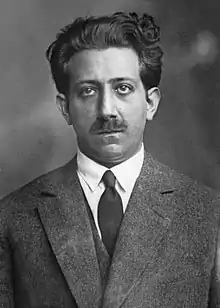Alexandre Stavisky
Serge Alexandre Stavisky (November 20, 1886 – January 8, 1934) was a French financier and embezzler whose actions created a political scandal that became known as the Stavisky Affair.[1][2]
Alexandre Stavisky | |
|---|---|
 Alexandre Stavisky in 1926 | |
| Born | November 20, 1886 Slobodka, Kiev Governorate, Russian Empire |
| Died | January 8, 1934 (aged 47) Chamonix, France |
| Resting place | Père Lachaise Cemetery |
| Occupation | Financier |
Early life
Alexandre Stavisky was a Polish Jew[3] born in modern-day Ukraine, whose Russian parents had moved to France.[4]
Career
Stavisky tried various professions, working as a café singer, as a nightclub manager, as a worker in a soup factory, and as the operator of a gambling den. He received French citizenship in 1910. In the 1930s he managed municipal pawnshops in Bayonne but also moved in financial circles. He sold lots of worthless bonds and financed his "hockshop" on the surety of what he called the emeralds of the late Empress of Germany — which later turned out to be glass. In 1927, Stavisky was put on trial for fraud for the first time, charged with a 6 million pound fraud. However, the trial was postponed again and again, and he was granted bail 19 times.
Faced with exposure in December 1933, Stavisky fled. On 8 January 1934, the police found him in a Chamonix chalet dying from two gunshot wounds to the head. Surgeons struggled to save him but he died early in the hours of January 9.[5] Officially, Stavisky committed suicide, but it was widely speculated that he was murdered to keep him silent.
In the aftermath there were many riots on the streets of Paris, resulting in 250 arrests on January 10 as news of government involvement in the financial scandal broke.[6] The French premier Camille Chautemps was forced to resign owing to the number of ministers wrapped up in the affair, and rumours that he had ordered Stavisky's assassination. An official public enquiry was ordered into the affair. Shortly before it began a senior judge, Albert Prince, who was due to be a witness, was found murdered on a railway line near Dijon, having been tricked to go there from Paris by means of a bogus telegram claiming his mother was very ill.[7]
Death and legacy
Stavisky died on January 8, 1934, in Chamonix. He was buried in Père Lachaise Cemetery in Paris.
The lyrics of the 1934 tango Cambalache contrasts Stavisky and other figures, arriving to the pessimistic conclusion that no one cares to tell good from evil.
Hollywood released a depiction in 1937 with Stolen Holiday, starring Claude Rains as Stavisky's fictional counterpart, Stefan Orloff, and Kay Francis as his wife. Stolen Holiday asserted unequivocally that Orloff was shot by police and his death made to look like a suicide.
In Forces occultes, a film commissioned in 1942 by the "Propaganda Abteilung", a delegation of Nazi Germany's propaganda ministry within occupied France, Stavisky was presented as both a Freemason and a crook.
In 1974, film director Alain Resnais told the story in the film Stavisky... that featured Jean-Paul Belmondo in the title role and Anny Dupérey as his wife Arlette.
References
- Paul Jankowski, Stavisky - A Confidence Man in the Republic of Virtue, (2002)
- David Clay Large, Between Two Fires: Europes Path in the 1930s (W.W.Norton: 1990) pp 24-58
- Kathy Warnes. "The Stavisky Affair - Sasha the Suave Scammer". historybecauseitshere. Retrieved 5 April 2018.
- Paul Jankowski, Stavisky – A Confidence Man in the Republic of Virtue (2002)
- Daily Mirror headline, January 9, 1934,
- Daily Mirror headline January 10, 1934
- Daily Mirror headline, 22nd February 1934
Further reading
- Paul Jankowski, Stavisky - A Confidence Man in the Republic of Virtue, (2002) ISBN 0-8014-3959-0
- Large, David Clay, Between Two Fires: Europes Path in the 1930s (W.W.Norton: 1990) pp 24–58, a scholarly account